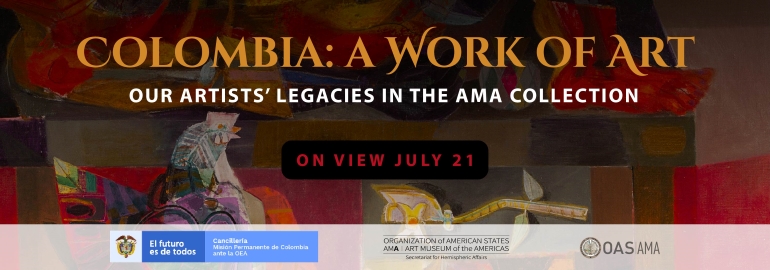Colombia: A Work of Art
Our Legacies in the AMA Collection
On view July 21, 2022 through April 2, 2023
This exhibition commemorates the visual arts of Colombia and
the
vital role they have played in the development of modern and
contemporary art of the region. As an OAS member state,
Colombia has engaged in a vibrant culturally diplomatic
relationship with the Organization and its Visual Arts Unit
and subsequent Museum of Modern Art of Latin America, today
the AMA.
As early as the first Inter-American Conference in 1889,
Colombia has facilitated cultural exchange of the Americas,
and was central to the establishment of the Columbus Memorial
Library of the present-day OAS, a unique resource utilized by
researchers to this day. The founding of the OAS
in Bogotá in 1948 and the administration of its first
Colombian Secretary General Alberto Lleras Camargo (1948-1954)
coincided with the appointment of Cuban art critic José Gómez
Sicre (b. 1916, d. 1991) as the first director of the OAS art
program.
In 1948, Luis Alberto Acuña: Paintings from
Colombia became the first solo exhibition by a Colombian
artist at the OAS. The OAS acquired numerous outstanding
Colombian works during Gómez Sicre’s tenure (1948-1982). These
include Alejandro Obregon’s The Dead Student (The Vigil),
recipient of the 1956 Guggenheim Award; Armando Villegas’s
Panorama eléctrico (1958), exemplary of the artist’s
distinctly Andean abstraction; Beatriz Echeverri’s Katty
sculpture, representing the female form; and
Fanny Sanín’s Acrylic No. 6, 1979 (1979), a fine rendering of
her balanced and symmetric style; among numerous others, many
seen here. To date, the AMA has accessioned 118 works of
Colombia art into its collection.
José Gómez Sicre further developed the relationship
between the arts of the hemisphere and Colombia, and was key
to the establishment of museums of modern art in Cartagena and
Barranquilla, opened in 1959 and 1960 respectively. As the
director of the OAS art program, Gómez Sicre organized
numerous exhibitions of work of Latin American artists
exemplifying budding artistic trends of the day, many of whom
held their first exhibitions in the United States at the OAS.
In 1960, Gómez Sicre organized 3,000 Years of Colombian Art at
the OAS Hall of the Americas and at the Low Museum in Miami
and sponsored by the International Petroleum Corporation of
Colombia.
During the subsequent directorships of Venezuelan Bélgica
Rodríguez (1988-1995) and Colombian Ana María Escallón
(1995-2004), the collection expanded with works on paper by
Maria de la Paz Jaramillo and Oscar Muñoz, sculptural wall
pieces by Olga de Amaral and Carolina Mayorga, and photographs
by and Gilma Suarez. Escallón’s time also coincided with the
Cesar Gaviria Trujillo administration as OAS Secretary General
(1995-2004), providing Colombia with the distinction of being
the sole OAS member state to have provided two Secretaries
General.
As a member state, Colombia has sought to
strengthen and promote mutual admiration of the cultural
legacies of the Americas as part of the region’s common
history and mutual recognition. The OAS AMA | Art Museum of
the Americas strives to promote the legacies of the rich and
diverse arts of the region, as important elements of the
hemisphere’s shared social fabric.
Colombia: Una Obra de Arte
Nuestros legados en la colección permanente del AMA
Esta
exposición conmemora las artes visuales de Colombia y el rol
central que han jugado en el desarrollo del arte moderno y
contemporáneo de la región. Como Estado miembro de la OEA,
Colombia ha entablado una relación vibrante a nivel de
diplomacia cultural con la Organización y su Unidad de Artes
Visuales y posterior Museo de Arte Moderno de América Latina,
hoy AMA.
Desde la
primera Conferencia Interamericana en 1889, Colombia facilitó
el intercambio cultural de las Américas y fue fundamental para
el establecimiento de la Biblioteca Colón de la actual OEA, un
recurso único utilizado hasta el día de hoy por los
investigadores. La fundación de la OEA en Bogotá en 1948 y la
administración de su primer Secretario General, el colombiano
Alberto Lleras Camargo (1948-1954), coincidieron con el
nombramiento del crítico de arte cubano José Gómez Sicre (n.
1916, d. 1991) como primer director del programa de arte de la
Organización.
En 1948,
Luis Alberto Acuña: Pinturas de Colombia, se convirtió en la
primera exposición individual de un artista colombiano en la
OEA. La Organización adquirió numerosas obras destacadas de
Colombia durante el mandato de Gómez Sicre (1948-1982). Estos
incluyen El Estudiante Muerto (La vigilia) de Alejandro
Obregón, ganador del Premio Guggenheim de 1956; Panorama
Eléctrico (1958) de Armando Villegas, ejemplar de la
abstracción netamente andina del artista; la escultura Katty
de Beatriz Echeverri, que representa la forma de la mujer; y
Acrylic No. 6, 1979 (1979) de Fanny Sanín, una fina
interpretación de su estilo equilibrado y simétrico; entre
otros, muchos vistos aquí. A la fecha, el AMA ha incorporado a
su colección 118 obras de arte colombiano.
José Gómez Sicre desarrolló aún más la
relación entre las artes del hemisferio y Colombia, y fue
clave para el establecimiento de los museos de arte moderno en
Cartagena y Barranquilla, inaugurados en 1959 y 1960
respectivamente. Como director del programa de arte de la OEA,
Gómez Sicre organizó numerosas exposiciones de obras de
artistas latinoamericanos que ejemplificaban las tendencias
artísticas en ciernes del momento, muchos de los cuales
realizaron sus primeras exposiciones en los Estados Unidos en
la OEA. En 1960, Gómez Sicre organizó 3.000 Años de Arte
Colombiano en el Salón de las Américas de la OEA y en el Museo
Low de Miami con el auspicio de la Corporación Internacional
del Petróleo de Colombia.
Durante las
direcciones posteriores de la venezolana Bélgica Rodríguez
(1988-1995) y la colombiana Ana María Escallón (1995-2004), la
colección se amplió con obras sobre papel de María de la Paz
Jaramillo y Oscar Muñoz, los telares de Olga de Amaral, las
instalaciones de Carolina Mayorga, y fotografías de Gilma
Suarez. El tiempo de Escallón también coincidió con la
administración de César Gaviria Trujillo como Secretario
General de la OEA (1995-2004), quien otorgó a Colombia la
distinción de ser el único estado miembro que ha proporcionado
dos Secretarios Generales a la Organización.
Como Estado
miembro, Colombia ha buscado fortalecer y promover la
admiración mutua de los legados culturales de las Américas
como parte de la historia común y el reconocimiento recíproco
de la región. El Museo de Arte de las Américas se esfuerza por
promover los legados de las artes, ricas y diversas, de la
región como elementos importantes del tejido social compartido
del hemisferio.






